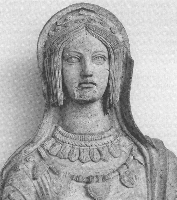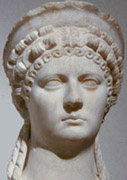

 |
Description: This course will focus on translation and discussion of Latin texts which portray Roman women in marriage, the family, and sexual relationships, and evidence male attitudes toward them, in a variety of literary forms (comedy, satire, love poetry, epic, myth, letters, history, inscriptions), from the 3rd Century BCE to the 2nd Century CE. |  |
| Dr. Ann R. Raia Associate Professor of Classics Faculty Home page Email: araia@cnr.edu |
Office: Castle 325 Phone: (914) 654-5398 Office Hours: W 1:30-2, Th 11:30-12:30, & by appointment |
Course Objectives and Anticipated Outcomes: at the conclusion of this course, students will be able to demonstrate:
Materials of Instruction:
Print Course Texts:
S. Ciraolo, ed. Cicero: Pro Caelio.
Wauconda, Ill.: Bolchazy-Carducci, 1999
H. Gould, J. Whiteley, eds. Titus
Livius Book I. London: Bristol Classical Press, 1964
P. Shore. Rest
Lightly: An Anthology of Latin and Greek Tomb Inscriptions.
Bolchazy-Carducci, 1997
College-level Latin dictionary
College-level
Latin grammar
Print Course Packet: selected poetry, prose, and inscriptions in Latin and English, distributed throughout the semester.
On-Line Texts and Images:
Catullus,
Allison Barker
De Feminis
Romanis, C.A.E. Luschnig, et al. at Diotima
Feminae Romanae: The
Women of Ancient Rome, Suzanne Cross
House
of Paullus Aemilius Lepidus and Cornelia
Inscriptions
Intermediate Latin Readings, A. Raia,
et al.
Latin Library
Pliny, Letters: selected by
H. Walker
Roman Perseus:
Catullus, Livy, Plautus, Vergil
VRoma: images
Women’s Life
in Greece and Rome by M. Lefkowitz and M. Fant, at Diotima
Supplementary Primary Source Readings:
Suzanne Dixon.
Reading Roman Women: Sources, Genres, and Real Life. London: Duckworth,
2001
E. Fantham, H.P. Foley, N.B. Kampen, S.B. Pomeroy, H.A. Shapiro, eds.
Women in the Classical World: Image and Text. New York: Oxford
University Press, 1994
Kleiner, Diana E. E., Susan Matheson, eds. I,
Claudia: Women in Ancient Rome. New Haven: Yale University Art Gallery,
1996
Kleiner, Diana E. E., Susan Matheson, eds. I, Claudia II: Women in
Roman Art and Society. Austin: University of Texas Press,
2000
M.Lefkowitz, M. Fant. Women’s Life in Greece and Rome: A
Sourcebook in Translation. Baltimore: Johns Hopkins UP, 1992, 2nd
ed.
N. Lewis, M. Reinhold, eds. Roman Civilization: Sourcebook I:
The Republic, Sourcebook II: The Empire. New York: Columbia
University Press, 1966
Susan Martin, “Private Lives and
Public Personae: the Laudatio Turiae”
J. Shelton. As The
Romans Did: A Sourcebook in Roman Social History. New York: Oxford
University Press, 1998, 2nd ed.
Ancillary Materials:
Course Bibliography
Diotima's Bibliography
B. McManus' pages on Roman
Names,
Clothing,
House,
Social Class
J.
Ruebel & M. Arnush's
Timeline of Roman History
Videos, slides, maps, commentaries and guides to readings
Course
management system for on-line syllabus, student conferencing, document posting
and reading, project presentation, sharing relevant links
Methods of Instruction:
Class time will be used primarily
for:
Special sessions will be scheduled for a guest lecture, slide shows, computer workshops, videos, student project presentations.
Course Requirements and Assessment Methods: Daily recitation, Class activities, Assignments, Projects, Final Exam
Students are expected to--
*Semester Projects:
1. Two Options:
Choose one, for presentation on October 17:
Inscriptions & Images: These texts, from a variety of time
periods, provide an opportunity to “see” Roman women of all classes
through non-privileged writing on epitaphs and through sculptural and painted
images. Translate an assigned inscription, making note of the conventions
of the genre of tomb and tribute inscriptions. Search the Internet for and
choose an appropriate sculpture or painted image of a Roman woman. Research
both in on-line and print sources. Post your translation, source links, and
analysis of text & image on the course management system in preparation for
your class presentation.
Women in Roman
Comedy: Stock characters of middle-class female types offer insights
into the lives of and attitudes towards Roman women during the mid-Roman
Republic. Choose one of Plautus' plays (Miles, Rudens,
Truculentus) to read in a good English translation. Survey bibliography
on your play and read at least two articles/book chapters (one will be
assigned). Select a scene to translate from Latin for its focus on women,
noting the vocabulary used to describe or identify them. Prepare a plot
summary, listing female characters organized into stereotypes. Analyze their
characterization, including their attitudes toward themselves and male
attitudes to and assumptions about them. Compare these caricatures to women's
social roles and attitudes presented in non-comic texts.
2. Latin Text Commentary (click
here for detailed
instructions):
Few Latin texts about women with commentaries are
available to readers. This final project will make a contribution to annotated
texts on women and will be your summative independent learning experience.
Select a complete text or a portion of a text
from the list provided; research the text in print and electronic sources;
develop a glossary and notes on grammar and content appropriate for an
intermediate-level Latin student.
Once you have
entered your completed work as a document in the course management system,
classmates will read your text-commentary, translate it, and post both their
translation and critique of your commentary.
Corrected and revised projects may be placed on
VRoma and/or offered to Dr. C. Luschnig, who invited our
class to submit their projects for possible addition to her on-line anthology
of Latin texts on women De Feminis
Romanis.
Grading: Students will be graded on the quality of their
completion of the requirements listed above as follows:
50 % --participation, recitation, daily assignments, quizzes*
30 % --two independent projects
20 % --final examination
*students who exceed the maximum
number of un-excused absences (4 in a 75 minute class) will find their grade
negatively affected in this category.
Course Policies: attendance is required, as is appropriate class behavior; students are expected to meet deadlines: un-excused late assignments will not be accepted; make-ups will be arranged for students who have medical or other serious excuses; students are expected to report an illness through proper channels; those found cheating or plagiarizing will earn an F for the course. At the beginning of the course, students with documented special needs are expected to inform the instructor of accommodations or services needed for successful academic participation.
Topical Outline of Course Content: PUELLA, MATRONA, MERETRIX, AMICA
The course topics derive from the theme of
the course: Roman Women. Selected texts, organized into four categories,
span the 3rd Century BCE to the 2nd Century CE. The readings illustrate both
the positive and negative images of women within the category; they evidence
variations of the female role within the category; they treat historical women,
legendary women, and literary constructs; they are almost solely narrated from
the male perspective, a point of view that secondary readings will help to
challenge.
The course begins with the least
complicated female role of the course title, puella, and proceeds to the
most complex, amica, which is not named in the course title. It moves
from the level of reading texts as evidence of real women’s lives to
questioning the texts by examining stereotypes, counter-stereotypes,
conflicting texts, socio-economic levels, gender bias, and genre conventions.
Readings will be found in our primary texts
(Livy AUC Book I and Cicero, Pro Caelio), on line, and in your
course packet materials.
Schedule: Class meets Tuesdays and Thursdays at 2-3:15 in Chidwick 206
Assignments are given daily, in response to the differing levels of
Latin expertise in the class and to my preferred pedagogy of advancing language
competence through sight translation.
Additional information will be given
in advance for the following special sessions:
Class will NOT meet: October 15, October 31, November 28, for which alternative arrangements will be made.
Thursday, September 5:
Introduction to the course content,
pedagogy, syllabus, and the four units
Unit I: September 10-24: Readings about and discussion of
Puella
Course text: Livy,
Ab Urbe Condita, Book I, selections
Additional Readings: J. Hallett, “Women in the Ancient Roman
World” in B. Vivante, Women’s Roles in Ancient Civilizations: A
Reference Guide; J. Gardner, "Legendary Ladies" in Roman Myths
Unit 2: October 8-November 19: Readings about and discussion
of Matrona
Course Text:
Cicero, Pro Caelio, selections on Clodia
November
14: Illustrated guest lecture "Women in Roman Society,"
Barbara McManus
Additional Readings: Jane Gardner, Th. Wiedemann, eds.,
"The Laudatio Turiae," in The Roman Household, pp. 48- 52,
illustration #28; Suzanne Dixon, "The allure of 'La Dolce Vita' in Ancient
Rome," chapter 9, in Reading Roman Women
Unit 3: November 21-November 26: Readings about and discussion
of Meretrix
Additional Reading: A. Raia, Women's
Roles in Plautine Comedy
Unit 4: December 3-December 12: Readings about and discussion
of Amica
December
3: First Draft of Commentary Project
due
December 12: Second Draft of Commentary Project
due; class peer critiques of commentaries
Additional Reading: Giusto Traina, "Lycoris the Mime," in Augusto
Fraschetti, ed., Roman Women, tr. Linda Lappin.
December 18:
Final Examination, Final Draft of Commentary
Project, Evaluation:
Kimberly Nickerson,
Commentary to Pliny's
EpistulaeVII.24
Jennifer Pinheiro,
Commentary to Cicero's
Pro CluentioV.12-VI.17
Cara West,
Commentary to Seneca's
De Consolatione ad Marciam 3.3-4.3